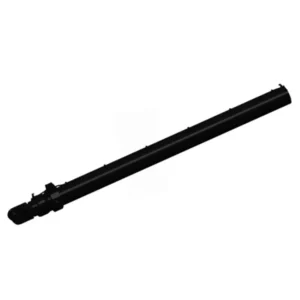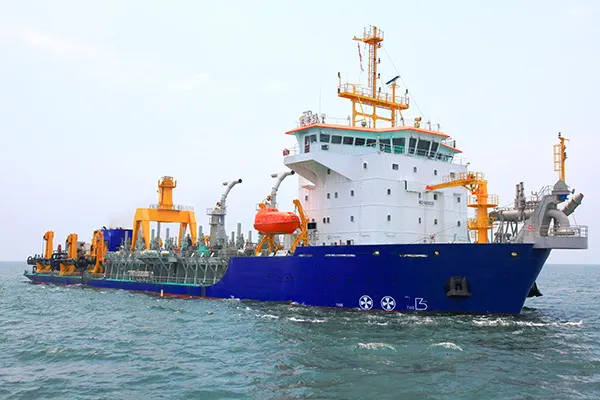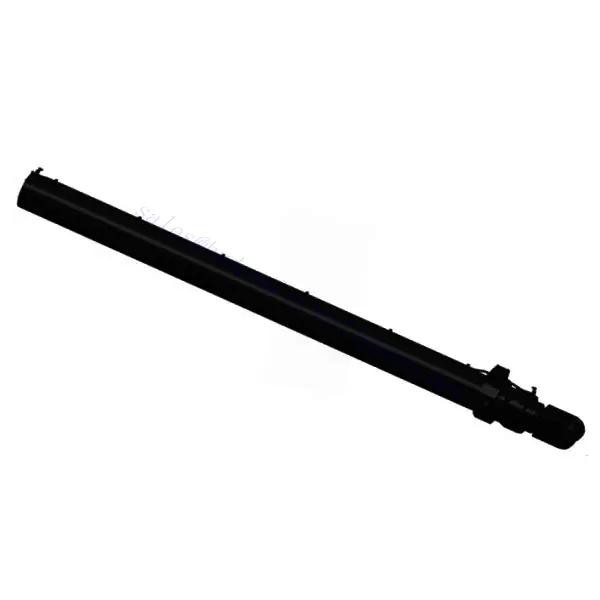Cutter Suction Dredger Inverted Pile Cylinder
Como um dos fabricantes, fornecedores e exportadores de produtos mecânicos de cilindros hidráulicos, oferecemos cilindros hidráulicos e muitos outros produtos.
Entre em contato conosco para obter detalhes.
Correio eletrônico:sales@hydraulic-cylinders.net
Fabricante, fornecedor e exportador de cilindros hidráulicos.
Cutter Suction Dredger Inverted Pile Cylinder

The cutter suction dredger inverted pile cylinder is a groundbreaking hydraulic device transforming marine construction projects. With its innovative design and exceptional performance, this cylinder is crucial to modern dredging operations.
The cutter suction dredger inverted pile cylinder has revolutionized marine construction by offering exceptional performance in piling operations. Its inverted design, high-pressure capacity, and corrosion resistance make it a reliable and durable hydraulic device. By following proper usage methods and carrying out regular maintenance, marine construction professionals can maximize the efficiency and accuracy of their projects. Embrace the power of the cutter suction dredger inverted pile cylinder and experience the difference it can make in your marine construction endeavors.
Cutter Suction Dredger Inverted Pile Cylinder Key Characteristics:
- Inverted Design: The cutter suction dredger inverted pile cylinder boasts a unique inverted configuration, with the piston rod extending downward from the cylinder. This design allows for efficient and precise piling operations in marine environments.
- High-Pressure Capacity: This cylinder is engineered to withstand high-pressure conditions, ensuring reliable and robust performance even in challenging marine construction projects. It delivers the power and force necessary for driving piles into the seabed with exceptional accuracy.
- Corrosion Resistance: Constructed from high-quality materials, the inverted pile cylinder exhibits excellent resistance to corrosion, rust, and abrasion. This feature enhances its durability, making it suitable for prolonged use in harsh marine conditions.
Cutter Suction Dredger Inverted Pile Cylinder Parameter:
| Product Name | Cutter Suction Dredger Inverted Pile Cylinder |
| Features: | Provide push and pull force for the retracting and unfolding of the steel pile |
| Bore diameter: | Up to 620 mm |
| Rod diameter: | Up to 360 mm Stroke up to 5200 mm |
| Pressure: | up to 32MPa |
| Thrust force: | Maximum 7500KN |
| Pulling force: | Maximum 5000KN |
| Applications: | Cutter Suction Dredger |
Rod diameter: up to 360mm
Stroke up to 5200mm
Dredger Tank Cutter-Suction Cylinders Application:

Usage Method Of Cutter Suction Dredger Inverted Pile Cylinder:
- Preparation: Before using the cutter suction dredger inverted pile cylinder, ensure all safety precautions are in place. Conduct a visual inspection to verify that the cylinder and its components are in good condition, with no signs of damage or leaks.
- Positioning: Position the cylinder in the desired location for piling. Ensure that it is securely attached to the dredger or other equipment, providing stability and support during the operation.
- Connection: Connect the hydraulic hoses or fittings to the appropriate ports on the cylinder and the hydraulic power source. Confirm that the links are secure, leak-free, and properly aligned.
- Adjusting Stroke Length: Adjust the stroke length of the cylinder according to the required piling depth. This can typically be done using the controls or mechanisms provided. Follow the manufacturer’s instructions to ensure precise adjustment.
- Piling Operation: Activate the hydraulic power source to initiate the piling operation. The cutter suction dredger inverted pile cylinder will exert controlled force to drive the piles into the seabed. Monitor the process closely, ensuring the desired depth and accuracy are achieved.
How To Replace Seals On A Hydraulic Cylinder?
Replacing seals on a hydraulic cylinder is a common maintenance task that helps restore its performance and prevent leaks. Here’s a step-by-step guide on how to replace seals on a hydraulic cylinder:
- Precauções de segurança:
- Ensure the hydraulic system is depressurized, and the cylinder is fully extended.
- Follow proper lockout/tagout procedures to prevent accidental activation of the system.
- Remoção do cilindro:
- Disconnect any hydraulic hoses or fittings connected to the cylinder.
- Remove any retaining pins or bolts securing the cylinder to the equipment.
- Carefully slide or maneuver the cylinder out of its mounting brackets or connections.
- Seal Identification:
- Identify the types and sizes of the seals that need replacement. This information can be found in the cylinder’s documentation or by measuring the old seals.
- Disassembly:
- Place the cylinder on a clean work surface.
- Remove the end cap(s) of the cylinder using appropriate tools, such as wrenches or socket sets.
- Carefully remove the piston, rod, and old seals from the cylinder barrel.
- Take note of the order and orientation of the components as you disassemble them.
- Seal Removal:
- Gently remove the old seals from their respective grooves using seal removal tools or picks.
- Be careful not to damage the cylinder bore or other surfaces during this process.
- Cleaning and Inspection:
- Clean the cylinder barrel, piston, rod, and other components using a suitable cleaning solvent to remove dirt, debris, and hydraulic fluid residue.
- Inspect all parts for signs of damage or wear, such as scoring, pitting, or cracks.
- Replace any damaged or worn components as necessary.
- New Seal Installation:
- Lubricate the new seals with hydraulic oil before installing them.
- Carefully insert the new seals into their respective grooves, ensuring they are properly seated.
- Use seal installation tools or suitable improvised methods to press the seals evenly into place.
- Be cautious not to damage the seals during the installation process.
- Remontagem:
- Install the piston, rod, and seals back into the cylinder barrel, following the correct order and orientation.
- Apply a thin layer of hydraulic oil to the seals and other contact surfaces.
- Carefully reattach the end cap(s) and tighten them securely to the manufacturer’s specifications.
- Ensure all threaded connections are properly aligned and tightened.
- Cylinder Reinstallation:
- Slide or maneuver the reassembled cylinder back into its mounting brackets or connections.
- Reattach any retaining pins or bolts to secure the cylinder in place.
- Reconnect the hydraulic hoses or fittings to the cylinder, ensuring proper alignment and tightness.
- Teste e inspeção:
- Re-pressurize the hydraulic system and check for any leaks or abnormal operation.
- Fully extend and retract the cylinder to ensure smooth movement and proper functioning.
- Inspect the cylinder and its connections for any signs of leakage or other issues.
Aptidão e capacidade da fábrica:
(1) Montagem
Temos uma plataforma de montagem de pesquisa e desenvolvimento independente de primeira classe. A oficina de produção de cilindros hidráulicos tem quatro linhas de montagem semiautomáticas de cilindros de elevação e uma linha de montagem automática de cilindros de inclinação, com uma capacidade de produção anual projetada de 1 milhão de peças. A oficina de cilindros especiais é equipada com várias especificações de um sistema de montagem de limpeza semiautomática com uma capacidade de produção anual projetada de 200.000 peças e equipada com famosos equipamentos de usinagem CNC, um centro de usinagem, um equipamento especial de processamento de cilindros de alta precisão, uma máquina de solda robotizada, uma máquina de limpeza automática, uma máquina de montagem automática de cilindros e uma linha de produção de pintura automática. O equipamento crítico existente é de mais de 300 conjuntos (conjuntos). A alocação ideal e o uso eficiente dos recursos do equipamento garantem os requisitos de precisão dos produtos e atendem às necessidades de alta qualidade dos produtos.


(2) Usinagem
A oficina de usinagem é equipada com um centro de torneamento de trilho inclinado personalizado, um centro de usinagem, uma máquina de brunimento de alta velocidade, um robô de soldagem e outros equipamentos relacionados, que podem lidar com o processamento de tubos de cilindros com diâmetro interno máximo de 400 mm e comprimento máximo de 6 metros.

(3) Soldagem

(4) Pintura e revestimento
Com linhas de revestimento de tinta à base de água automáticas de cilindros de pequeno e médio porte, para obter carregamento e descarregamento automáticos de robôs e pulverização automática, a capacidade projetada é de 4.000 peças por turno;
Também temos uma linha de produção de tinta semiautomática para cilindros grandes, acionada por uma corrente elétrica, com capacidade de projeto de 60 caixas por turno.


(5) Testes
Temos instalações de inspeção e bancos de teste de primeira classe para garantir que o desempenho do cilindro atenda aos requisitos.

We are one of the best hydraulic cylinder manufacturers. We can offer comprehensive hydraulic cylinders. We also provide corresponding caixas de câmbio agrícolas. Exportamos nossos produtos para clientes em todo o mundo e conquistamos uma boa reputação devido à qualidade superior de nossos produtos e ao serviço pós-venda. Convidamos clientes nacionais e estrangeiros a entrar em contato conosco para negociar negócios, trocar informações e cooperar conosco!
Faça um tour pela nossa fábrica de RV:
Faça um tour pela nossa fábrica de RV com o seguinte
Como funciona o cilindro hidráulico da empilhadeira?
Cilindro hidráulico Aplicação:


